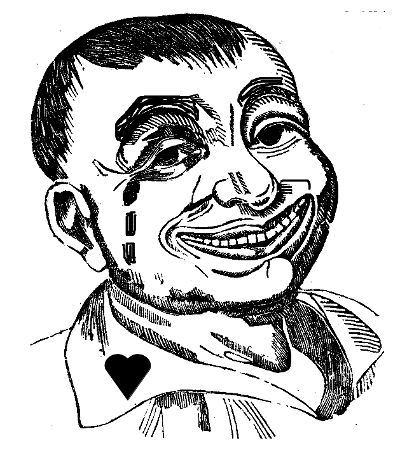Posts filed under “Art”
ARCHITECTURAL GUESSING GAME.
BOZAR THE CLOWN’S SEVEN AESTHETIC WORKS OF MERCY.

- Turning off the television.
- Unplugging and removing the amplification system from a concert hall.
- Correcting backwards apostrophes at the beginnings of words in signs and advertisements.
- Reeducating practitioners of “contemporary Christian music.”
- Teaching writers of popular lyrics the principles of rhyme.
- Using a fast shutter to capture a waterfall, in defiance of the motion-blurring convention of every inspirational poster in the dentist’s office.
- Teaching an art student to draw.
GREAT MOMENTS IN DANCE.
Willa de Wispe as the National Debt in Heyser’s ballet “Principles of Keynesian Economics for the Twenty-First Century.”
WHY WE CAN’T HAVE NICE THINGS.
No. 1: Music.

The face of not having nice things in music, by Egon Schiele.
Moses and Aron is based entirely on a single tone row, itself constructed from cells…
Okay, what’s a tone row?
In music, a tone row or note row (German: Reihe or Tonreihe), also series or set, is a non-repetitive ordering of a set of pitch-classes, typically of the twelve notes in musical set theory of the chromatic scale, though both larger and smaller sets are sometimes found.
Okay, what’s musical set theory?
Musical set theory provides concepts for categorizing musical objects and describing their relationships.
Right at the beginning of that article is a helpful illustration with this caption:
Example of Z-relation on two pitch sets analyzable as or derivable from Z17, with intervals between pitch classes labeled for ease of comparison between the two sets and their common interval vector, 212320
The reason we can’t have nice things in music is that only people who find this stuff absolutely fascinating are allowed to write serious music.
NEWLY DISCOVERED RELIEF DEPICTS JEPHTHAH’S ISRAELITE ARMY BATTLING THE AMMONITES.
ART CORNER.

Not Quite Horizontal Line, Almost but Not Quite Centered Vertically.

Not Quite Horizontal Line, Almost but Not Quite Centered Vertically, in Opposite Colors, to Make You Wonder Whether You Saw This Painting Already.

Perfectly Vertically Centered Horizontal Line, Maddeningly Extending Almost but Not Quite All the Way to the Right Edge.

Vertically Centered Horizontal Line—OR IS IT?

Diagonal Line in Exactly the Wrong Place.

Bunch of Lines in the Wrong Colors.
NEWLY DISCOVERED RENAISSANCE PORTRAIT.
The original woodcut, of course, represented the bull alone, illustrating the article De Tauro in the 1551 edition of the Historiae Animalium of Conradus Gesnerus. It was hand-colored, probably soon after the book was originally purchased. Some time later, a talented artist of the grotesque school, known for its combining of human with animal and vegetable forms, added the head in profile arising from the rearward parts of the animal.
What is the meaning of this unusual juxtaposition? Doubtless the artist meant to compliment his friend or patron by associating him with the power and nobility of the bull. Centuries later, we can no longer identify the subject of the portrait, but the intended compliment is legible to a wider audience than the artist could ever have imagined.
DEATH AS POP ART.
You will notice that Andy lies under a perfectly ordinary grave marker, indistinguishable from thousands of other grave markers installed in the late 1980s. That in itself may be seen as the consummation of a career devoted to finding the art in the ordinary.
If you make a pilgrimage to Pittsburgh, the land of Warhol, you may begin at the Andy Warhol Museum, which (with seven floors of Warhol) claims to be the largest museum in the world dedicated to a single artist. Then you can walk to the North Side subway station, where you can catch a Blue Line car and ride about half an hour out into the suburbs to Washington Junction, which is an easy walk from St. John the Baptist Byzantine Catholic Cemetery.
But, you ask, if his monument is indistinguishable from everyone else’s, how will I find it in the cemetery? No need to worry. The cameras will point the way. Andy Warhol lies a mouldering in the grave, and his mouldering is livestreamed to the world, brought to you by the Byzantine parish he grew up in.
Empire was only a dress rehearsal. Andy Warhol is still working on the greatest avant-garde film of all time.
The pictures are from Father Pitt’s Pittsburgh Cemeteries. Like most of Father Pitt’s work, they are released into the public domain.
A HALLOWEEN STROLL.

You will see all those things everywhere else on the Internet, so Dr. Boli thought he would set aside a day to celebrate beauty instead. Halloween is a perfect day for a stroll through a cemetery, and we borrow these pictures from Father Pitt, who took them all in one afternoon’s leisurely strolling in Allegheny Cemetery, Pittsburgh. Every picture is provided in full resolution: you can click on any one of them to enlarge it and examine the details.

The Winter mausoleum was designed by John Russell Pope, architect of the National Archives, the Jefferson Memorial, the National Gallery of Art, &c., &c. If you have money (Emil Winter was a banker), distinguished architects are at your beck and call. If Dr. Boli decides to die at some point in the near enough future, he plans to have a mausoleum designed by Frank Gehry.

An extraordinarily fine stained-glass window in the Flower mausoleum.

Many sections of the cemetery are quite prickly with obelisks.

A picture of mourning and consolation on the Graham family monument.

The cemetery’s Penn Avenue gatehouse, with its weighty Romanesque tower, finished in 1889. The architect was Henry Alexander Macomb, a Philadelphia architect who won the cemetery’s design competition.
Many other beautiful and fascinating monuments can be found at Father Pitt’s Pittsburgh Cemeteries, a fine place to spend a few hours for Halloween.
ART CORNER.
Apparition of St. Carmen Miranda, by an unknown Baroque artist who was even baroquer after this image appeared.




